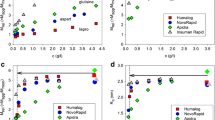Abstract
A highly active cyclic hexapeptide analogue of somatostatin, Cyclo(N-Me-L-Ala-L-Tyr-D-Trp-L-Lys-L-Val-L-Phe), L-363,586, was found to improve the control of postprandial hyperglycemia in diabetic animals when given in combination with insulin. The compound is reported to be relatively stable in blood, nasal cavity, and intestinal lumen but undergoes rapid degradation in aqueous solution. The objective of this study was to elucidate the degradation mechanisms based on the kinetic data and the structure of the degradation products. Both pH and temperature had a profound influence on the instability of the peptide in aqueous solution. The data indicated that the peptide was most stable at a pH of about 4.7. The pH-rate profile exhibited specific acid catalysis at a pH less than 3.0 and base catalysis above pH 10.5. The kinetic pK a was determined to be 9.7. This pK a could be attributed to the tyrosine residue. The mechanisms of degradation under acidic and alkaline conditions appear to be different. Identification of the fragments obtained using mass spectrometry and amino acid sequencing suggest that the cyclic compound was cleaved to yield a linear fragment, which underwent further cleavage at both peptide linkages alpha to the trypto-phanyl residue. The indole group of that residue is probably the potential nucleophile attacking the adjacent carbonyls. A rate equation for the degradation of the hexapeptide has been proposed.
Similar content being viewed by others
REFERENCES
R. H. Unger. Glucagon physiology and pathophysiology. N. Engl. J. Med. 285:443–448 (1971).
J. E. Gerich. Somatostatin modulation of glucagon secretion and its importance in human glucose homeostasis. Metabolism 27:1283–1286 (1978).
J. E. Gerich, T. A. Schultz, S. B. Lewis, and J. H. Karam. Clinical evaluation of somatostatin as a potential adjunct to insulin in the management of diabetes mellitus. Diabetologia 13:537–544 (1977).
D. F. Veber, R. Saperstein, R. F. Nutt, R. M. Freidinger, S. F. Brady, P. Curley, D. S. Perlow, W. J. Paleveda, C. D. Colton, A. G. Zacchei, D. J. Tocco, D. R. Hoff, R. L. Vandlen, J. E Gerich, L. Hall, L. Mandarino, E. H. Cordes, P. S. Anderson, and R. Hirschmann. A super active cyclic hexapeptide analog of somatostatin. Life Sci. 34:1371–1378 (1984).
D. F. Veber, F. W. Holly, W. J. Paleveda, R. F. Nutt, S. J. Bergstrand, M. Torchiana, M. S. Glitzer, R. Saperstein, and R. Hirschmann. Conformationally restricted bicyclic analogs of somatostatin. Proc. Natl. Acad. Sci. USA 75:2636–2640 (1978).
D. F. Veber, R. M. Freidinger, D. S. Perlow, W. J. Paleveda, F. W. Holly, R. G. Strachan, R. F. Nutt, B. H. Arison, C. Homnick, W. C. Randall, M. S. Glitzer, R. Saperstein, and R. Hirschmann. A potent cyclic hexapeptide analogue of somatostatin. Nature 292:55–58 (1981).
W. Bauer, U. Briner, W. Doetner, R. Haller, R. Huguenin, P. Marbach, T. J. Petcher, and J. Pless. A potent and long acting somatostatin analog of somewhat larger molecular size also has been reported to be of sufficient interest to warrant human evaluation. Life Sci. 31:1133–1140 (1982).
C. R. Gardner, S. Selk, M. Cortese, and T. Higuchi. In-situ peptide absorption studies—uptake, binding or metabolism? Presented at the Higuchi Research Seminar, 17th Annual Meeting, Lake Ozark, MO, March 1986.
C. R. Gardner. Gastrointestinal barrier to oral drug delivery. In R. T. Borchardt, A. J. Repta, and V. J. Stella (eds.), Directed Drug Delivery, Humana Press, Clifton, NJ, 1985, pp. 61–81.
K. Patel and R. T. Borchardt. Chemical Pathways of Peptide degradation. II. Kinetics of Deamidation of an Asparaginyl Residue in a model Hexapeptide. Pharm. Res. 7:703–711 (1990).
M. C. Manning, K. Patel, and R. T. Borchardt. Stability of protein pharmaceuticals. Pharm. Res. 6:903–918 (1989).
S. F. Brady, R. M. Freidinger, W. J. Paleveda, C. D. Colton, C. F. Homnick, W. L. Whitter, P. Curley, R. F. Nutt, and D. F. Veber. Large scale synthesis of a cyclic hexapeptide analogue of somatostatin. J. Org. Chem. 52:764–769 (1987).
Enzfitter: A non-linear regression analysis program for the IBM PC by R. J. Leatherbarrow.
H. Eyring. Quantum mechanics and chemical reactions. Chem. Rev. 10:103–110 (1965).
H. Eyring. The activated complex and the absolute rate of chemical reactions. Chem. Rev. 17:65–69 (1935).
E. Tanford. The interpretation of hydrogen ion titration curves of proteins. Adv. Protein Chem. 17:69–165 (1962).
A. Fersht. The pH dependence of enzyme catalysis. In Enzyme Structure and Mechanism, 2nd ed., W. H. Freeman, New York, 1985, pp. 155–175.
D. F. Veber. Peptides: Synthesis, structure, function. In D. H. Rich and E. Gross (eds.), Proceedings of the Seventh American Peptide Symposium, Pierce Chemical Co., Rockford, IL, 1981, pp. 685–694.
B. H. Arison, R. Hirschmann, and D. F. Veber. Inferences about the conformation of somatostatin at a biologic receptor based on NMR studies. Bioorg. Chem. 7:447–451 (1978).
Author information
Authors and Affiliations
Rights and permissions
About this article
Cite this article
Krishnamoorthy, R., Mitra, A.K. Kinetics and Mechanism of Degradation of a Cyclic Hexapeptide (Somatostatin Analogue) in Aqueous Solution. Pharm Res 9, 1314–1320 (1992). https://doi.org/10.1023/A:1015813619192
Issue Date:
DOI: https://doi.org/10.1023/A:1015813619192




